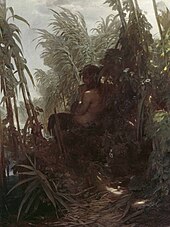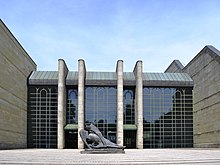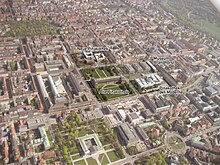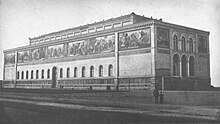New Pinakothek gallery

The Neue Pinakothek ( ) in Munich is a museum of 19th century European art. Located in the Munich art area, it represents a link between its two sibling institutions - the Alte Pinakothek with the Old Masters and the Pinakothek der Moderne for the art of the 20th and 21st centuries.
The Neue Pinakothek (from Greek πινακοθήκη pinakotheke, “picture hall”, “painting collection”) offers an overview of the epochs of European art from the Enlightenment to the dawn of modernity - from Goya and David to van Gogh and Cézanne - and thus spans the late 18th, the entire 19th and the beginning of the 20th century. In addition to paintings and sculptures from Classicism , works from Romanticism , Art Nouveau and Impressionism can be seen.
The stock of the Neue Pinakothek includes more than 6,000 works and is since 1915 part of the Bavarian State Painting Collections which a substantial portion of paintings and art collection with more than 30,000 objects of the Free State care.
Since January 1, 2019, the building has been completely closed for a comprehensive general renovation until probably after 2025, during this time a selection of works can be seen in the east wing of the Alte Pinakothek and in the Schack Collection .
history
Founding by King Ludwig I.
The gallery was designed by Ludwig I founded the order after also led him build the Alte Pinakothek wanted to make his resulting since 1809 private collection of contemporary art to the public, at the same time she was also an exhibition area of Munich School provided. By 1853 the first Neue Pinakothek was built by August von Voit according to Friedrich von Gärtner's designs . After some other building sites had been discarded, the gallery building across from the Alte Pinakothek was built.
When it opened on October 25, 1853, the Neue Pinakothek was the first collection of “modern” art in the world and was intended to form a counterpoint to the royal Wittelsbach Old Masters who had been on display in the Alte Pinakothek since 1836.
For the time being, due to Ludwig's preferences, the main focus of the collection was on the Munich School and German Romanticism . The special focus was on the painters of the South German schools and academies. However, Ludwig I also pursued dynastic goals with the establishment of the museum, because once the paintings by Carl Rottmann , which depict Greece ruled by Ludwig's son Otto in heroic landscapes, were exhibited in the main hall. After Ludwig's death, other important works were gradually added, but Munich remained on familiar lines for a long time.
This only changed under the supervision of Hugo von Tschudi , who had been General Director of the Munich State Painting Collections since 1909. He turned his attention increasingly to the previously neglected modern French artists. The Neue Pinakothek owes its impressive collection of Impressionists to him , which came to the museum mainly after his death in 1911 as part of the “ Tschudi donation ”.
After the Second World War
In 1944, the Neue Pinakothek building was badly damaged by incendiary bombs in Anglo-American air raids. Five years later, the first stage in the history of the Neue Pinakothek ended with the decision to demolish the ruins. After a provisional presentation of some masterpieces in the undamaged Haus der Kunst from 1947, the postmodern new building of the Pinakothek, a work by the architect Alexander Freiherr von Brancas , was opened on March 28, 1981 , in order to topographically reconnect the sibling institutions - Alte Pinakothek and Neue Pinakothek unite. By 2002, the opening of the Pinakothek der Moderne in the immediate vicinity and in the same art complex , the situation for the Neue Pinakothek has changed again: four major museums of the 20th and 21st centuries under one roof - art, graphics, architecture and design. The Pinakothek der Moderne replaces the Neue Pinakothek in its original claim to present “contemporary” art and at the same time presents it with a new challenge: the concentration on painting and sculpture of the multifaceted 19th century and thus the linking of the three Pinakothek with each other. In spite of this, or precisely because of this, the limits of this show to a century are open: at the beginning with the bourgeois and classicist painting of the German 18th century, the art of England pointing to the future, with the bold drama of Goya , David's revolutionary claim and then at the end with the movement of young modernism that reached into the 20th century. The dividing line drawn here for the first time between old and new, which was set for the period shortly before 1800, was groundbreaking for German galleries.
The museum architecture of today's Neue Pinakothek
After an ideas competition in 1966/67, Alexander Freiherr von Branca was commissioned to build the new Pinakothek. The foundation stone was laid in 1975 and the new building opened on March 28, 1981. In addition to the gallery wing, Branca's architecture includes the administration wing of the Bavarian State Painting Collection and the Doerner Institute .
The new building, classified as post-modern, is at the center of a controversial discussion: the divergence of modern reinforced concrete construction and the facade design made of natural stone. While the accusation of architecture critics is that the architecture merely illusions the appearance of a natural stone building, this principle has long been known from the history of architecture - most recently and most succinctly from the Wilhelminian era , when the facades are made of less durable and purely decorative materials such as plaster of paris and stucco. While the history of art in the West seems to be full of retrospectives, the architecture of the Neue Pinakothek also makes use of well-known formal elements from architectural history, such as arched windows, keystones, bay windows and open stairs. However, Branca's abstract approach to these stylistic elements reveals his intention: apparently functionless gargoyles reflect the separation of function and aesthetics. The same applies to the divergence of reinforced concrete construction and natural stone facade.
While the exterior appears defined by countless interlocking cubes and is presented in ever new (perhaps confusing) views through fronts, extensions and superstructures, depending on the perspective, the architect attaches particular importance to the interior design and distribution of the gallery wing specific needs of museum architecture. Appropriate for the presentation of paintings, the visitor finds himself in gallery rooms with classic proportions and for illuminating paintings advantageous skylight lighting. Almost suddenly, following a natural movement, the visitor is guided through a sequence of rooms, within which he can experience the 19th century chronologically as far as possible. Branca explains: "The visitor shouldn't have to have scouting properties, but rather, following a natural 'gradient', 'flow through' the sequence of rooms". Nevertheless, visitors can return to the centrally located foyer almost at any time. Branca succeeds in meeting this spatial distribution requirement, which is often discussed in museum architecture, through two kinds of architectural measures: the basic shape of the sequence of rooms, which is modeled on the shape of an eight, and through a system of corridors parallel to the gallery rooms, which allows the presentation of 19th-century sculpture. Century.
While the exterior of the museum is staged as an imposing and multi-faceted building, the architecture in the area of the exhibition rooms takes a back seat in order to do justice to the function of museum architecture - to provide space for the presentation of art.
After reaching an agreement with the architect's heirs in summer 2019, the museum management may intervene in the facade as desired during the renovation. A glass cube on the edge of the main staircase will provide disabled access and the revolving doors will give way to a sliding element. Inside, the foyer can be changed and made more visitor-friendly, and the museum shop should also receive daylight. In addition, an open inner courtyard, which was previously inaccessible, will be roofed over and available to visitors for receptions and art education. As a result, the museum will have a good 200 square meters, while the exhibition area will otherwise remain the same. The new opening will therefore only take place after 2025.
collection
The Neue Pinakothek shows a constantly changing selection of more than 400 works from its holdings of over 3,000 paintings and 300 sculptures in the 22 halls and ten cabinets.






International art of the late 18th century
The collection includes works by Anton Raphael Mengs ( self-portrait , 1773), Anton Graff ( Heinrich XIII, Count Reuss , 1775), Francisco de Goya ( Die Landpartie , 1776; Don José Queraltó as a Spanish army doctor , 1802), Hubert Robert ( Demolition of the houses on the Pont au Change in Paris , 1788), Angelika Kauffmann ( self-portrait , 1784), Jacques-Louis David ( portrait of Anne-Marie-Louise Thélusson, Comtesse de Sorcy , 1790), Johann Heinrich Füssli ( Satan and Death , separated from sin , 1792/1802), Johann Friedrich August Tischbein ( Nicolas Châtelain in the Garden , 1791) and Johann Georg von Dillis ( Trivaschlösschen , 1797)
English painting of the late 18th and early 19th centuries
Almost all the important painters in England and Scotland from the 18th and early 19th centuries are exhibited in the Neue Pinakothek, including Thomas Gainsborough ( Landscape with Shepherd and Herd , 1784; Mrs. Thomas Hibbert , 1786), William Hogarth ( Richard Mounteney , 1746) , George Stubbs ( Chicken Dog , ca.1760 ), Joshua Reynolds ( Captain Philemon Pownall , 1769), Thomas Lawrence ( The Two Sons of 1st Earl Talbot , ca.1792), George Romney ( Catherine Clements , 1788), Richard Wilson ( View from Syon House across the River Thames at Richmond Gardens , ca.1765 ), Henry Raeburn ( Mrs. J. Campbell of Kilberry , 1802), David Wilkie ( Will and will , 1820), John Constable ( View from East Bergholt to Dedham Vale , 1825 ), and William Turner ( Ostend , 1844)
German classicism artists in Rome and Nazarenes
like Jakob Philipp Hackert ( Lago d'Averno , 1807), Joseph Anton Koch ( Heroic Landscape with Rainbow , 1815), Friedrich Overbeck ( Italia and Germania , 1828), Friedrich Wilhelm von Schadow ( Portrait of a young Roman woman , 1818), Heinrich Maria von Hess ( Marchesa Marianna Florenzi , 1824), Peter von Cornelius ( The three Marys at the grave , approx. 1822), Franz Ludwig Catel ( Crown Prince Ludwig in the Spanish wine tavern in Rome , 1824), Joseph Karl Stieler ( Johann Wolfgang von Goethe , 1828), Carl Rottmann ( Taormina with Mount Etna , probably 1829; Marathon , 1848) and Ferdinand Johann von Olivier ( Elias in the wilderness around 1831).
German romance
with works by Caspar David Friedrich ( gazebo , 1818), Johan Christian Dahl ( morning after a stormy night , 1819), Karl Friedrich Schinkel ( cathedral over a city , approx. 1830), Carl Blechen ( construction of the Devil's Bridge , 1830), Domenico Quaglio ( The old riding school with the Café Tambosi in Munich , 1822; view of the Villa Malta in Rome , 1830) and Johann Christian Reinhart (ensemble of four views: view from the Villa Malta in Rome , 1835) and others
Biedermeier
represented, for example, by Ludwig Richter ( Der Watzmann , 1824), Wilhelm von Kobell ( view of the Tegernsee , 1829/33), Joseph Anton Koch ( Landscape near Olevano with a riding monk , 1830), Franz Xaver Winterhalter ( Count Jenison-Walworth , 1837), Ferdinand Georg Waldmüller ( Young peasant woman with three children in the window , 1840), Moritz von Schwind ( A Symphony , 1852), Carl Spitzweg ( The poor poet , 1839; The institute walk , ca.1855)
French Realism and French Romanticism
with Théodore Géricault ( advancing artillery , ca.1814), Carle Vernet ( return from the hunt , 1828), Théodore Chassériau ( bathers , 1842), Eugène Delacroix ( Clorinde freed Olindo and Sophronia , ca.1855), Jean-François Millet ( Farmer grafting a tree , 1855), Charles-François Daubigny ( lock in the Optevoz valley , around 1855), Honoré Daumier ( The Drama , 1860), Gustave Courbet ( Landscape near Maizières , 1865) and others.
History and society painting
with works, for example, by Wilhelm von Kaulbach ( Ludwig I surrounded by artists and scholars , 1848), Karl Theodor von Piloty ( Seni in front of Wallenstein's corpse , 1855), Franz von Defregger ( The Last Aufgebot , 1872) and Hans Makart ( The Falconer , circa 1880).
Painting of the German Romans
in particular by Arnold Böcklin ( Im Spiel der Wellen , 1883), Anselm Feuerbach ( Nanna , 1861) and Hans Thoma ( Taunuslandschaft , 1890) as well as Hans von Marées ( self-portrait , 1883), of whom the Neue Pinakothek was donated by Fiedler (1891 ) owns numerous works that are threatened with slow extinction through the use of poor colors despite conservation efforts.
German realism
like Wilhelm Leibl ( portrait of Frau Gedon , 1868), Franz von Lenbach ( Dorfstrasse von Aresing , 1856), Adolph Menzel ( living room with Menzel's sister , 1847), Wilhelm Trübner ( seated mastiff , approx. 1877) and Carl Schuch ( still life with Apples, Wine Glass and Pewter Jug , ca.1876 )
German impressionists
especially with Max Liebermann ( bathing boys , 1898), Lovis Corinth ( Eduard Graf von Keyserling , 1901), Hubert von Heyden ( chicken farm , around 1897; poultry farm , around 1900), Fritz von Uhde ( heavy walk , 1890), Max Slevogt ( Ceremony , 1900) and August von Brandis ( Durchblick , 1904) and Ernst Oppler ( The Seamstress , before 1903)
French impressionists and post-impressionists
with works by Pierre-Auguste Renoir ( Portrait of a young woman , 1876; The gardens of Montmartre with a view of Sacré-Coeur under construction , 1896), Édouard Manet ( Le Déjeuner dans l'atelier , 1868; The Barque , 1874), Claude Monet ( Seine bridge at Argenteuil , 1874; water lilies , approx. 1915), Paul Cézanne ( The railway piercing , approx. 1870; still life with a chest of drawers , approx. 1883/1887), Paul Gauguin ( The birth - Te tamari no atua , 1896), Camille Pissarro ( Street in Upper Norwood 1871), Edgar Degas ( The Ironer , ca.1869 ), Alfred Sisley ( The Road to Hampton Court , 1874) and Vincent van Gogh ( The Weaver , 1884; Sunflowers , 1888; View of Arles , 1889; plain near Auvers, 1890 ) and Paul Sérusier ( The Laundresses , 1891).
Symbolism, Art Nouveau and the beginning of the 20th century

represented by Gustav Klimt ( Margaret Stonborough-Wittgenstein 1905), Giovanni Segantini ( Das Pflügen , 1887/1890), Fernand Khnopff ( I include myself , 1891), Paul Signac ( S. Maria della Salute , 1905), Maurice Denis ( Gallic herd goddess , 1906), Henri de Toulouse-Lautrec ( The young Routy at Céleyran Castle , 1882), James Ensor ( Still life in the studio , 1889), Ferdinand Hodler ( The tired of life , 1892), Franz von Stuck ( The sin , 1893), Edouard Vuillard ( scene in the café , 1903), Edvard Munch ( woman in a red dress (street in Aasgaardstrand) , 1902), Pierre Bonnard ( lady in front of the mirror , 1905) and Egon Schiele ( agony , 1912). Pictures from the first decade of the 20th century are already on display in the Pinakothek der Moderne .
Sculptures

There are also sculptures from the 19th and early 20th centuries on display, including by Bertel Thorvaldsen ( Adonis , 1802/1832), Antonio Canova ( Paris Statue , 1807–16), Rudolf Schadow ( Die Sandalenbinderin , 1813/1817), Honoré Daumier ( Ratapoil , 1851), Auguste Rodin ( Crouching , 1880/82), Max Klinger ( Elsa Asenijeff , approx. 1900), George Minne ( Jacques Francquaert , 1901), Aristide Maillol ( Flora , 1910), Pablo Picasso ( The Fool , 1905).
Placement program
The educational program is carried out by the visitor service and art education of the Pinakotheken as well as by the Munich Adult Education Center.
Movies
- Museum check with Markus Brock : Alte und Neue Pinakothek, Munich. Synopsis ( memento from January 10, 2017 in the Internet Archive ) by 3sat. First broadcast: January 15, 2012
literature
- Bayerische Staatsgemäldesammlungen (Ed.): Neue Pinakothek - catalog of paintings and sculptures . Munich (Pinakothek-DuMont) 2003.
- Bayerische Staatsgemäldesammlungen (Ed.): Neue Pinakothek Munich - Painting Catalogs , 8 volumes, Munich 1963–2003.
- The Neue Pinakothek - architecture experienced in photography . With articles and photos by Michael Künne, Munich (Karl M. Lipp Verlag) undated
- Veronika Schroeder (Ed.): New Pinakothek Munich . Munich / London / New York (Prestel) 1999.
Web links
- Official website
- Getting on in years: New Pinakothek in Munich
- Kulturportal bavarikon - paintings from the Neue Pinakothek as high-resolution digital copies
Individual evidence
- ↑ sueddeutsche.de Neue Pinakothek will be closed for at least six years , accessed on December 11, 2018
- ↑ Alexander Freiherr von Branca in: Die Neue Pinakothek - photographically experienced architecture. Photos by Michael Künne. Karl M. Lipp Verlag, Munich approx. 1985, p. 5.
Coordinates: 48 ° 8 ′ 59 ″ N , 11 ° 34 ′ 16 ″ E





